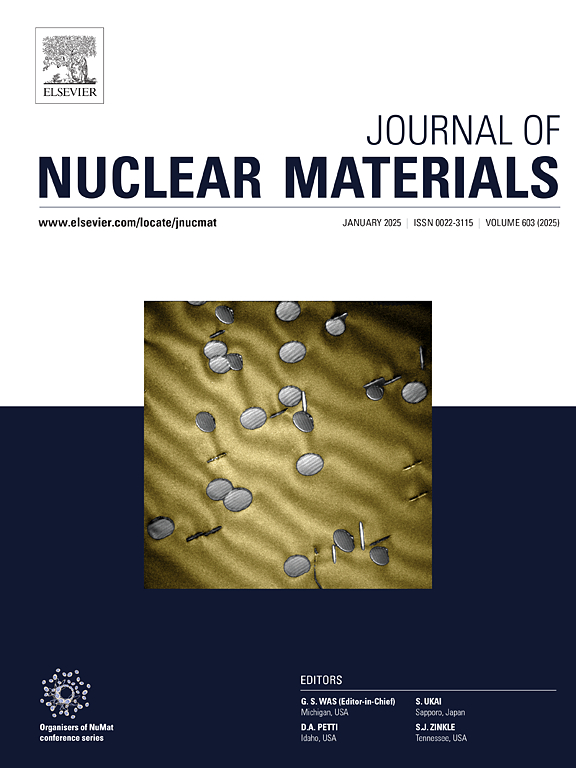Cu/W半相干界面结构对氦行为的影响:来自原子模拟的见解
IF 2.8
2区 工程技术
Q3 MATERIALS SCIENCE, MULTIDISCIPLINARY
引用次数: 0
摘要
采用原子模拟方法研究了具有Kurdjumov-Sachs取向关系的铜(Cu)/钨(W)纳米多层膜中氦(He)气泡的成核和生长。结果表明,He气泡的优先成核位置是靠近界面的低cu密度区域,特别是错配位错交叉点(MDIs),而不是传统假设的高界面能区域。此外,mdi He泡生长过程中的“血小板到球体”形态转变是位错介导的过程。在此基础上,提出了一种描述Cu/W纳米多层膜中He气泡成核和生长动力学的机制。这项工作促进了对纳米多层材料对He辐照耐受性的认识。本文章由计算机程序翻译,如有差异,请以英文原文为准。
Influence of Cu/W semi-coherent interfacial structure on helium behavior: insights from atomistic simulations
Atomistic simulations are conducted to investigate helium (He) bubble nucleation and growth in copper (Cu)/ tungsten (W) nano-multilayers with Kurdjumov-Sachs orientation relationship. The results reveal that the preferential nucleation sites for He bubbles are low-Cu density regions near interfaces, specifically at misfit dislocation intersections (MDIs), rather than the conventionally assumed high-interface energy regions. Moreover, the “platelet to sphere” morphological transformation during the He bubble growth at MDIs is a dislocation-mediated process. Based on these observations, a mechanism is proposed to describe the He bubble nucleation and growth dynamics in Cu/W nano-multilayers. This work advances the understanding of the tolerance to He irradiation of nano-multilayer materials.
求助全文
通过发布文献求助,成功后即可免费获取论文全文。
去求助
来源期刊

Journal of Nuclear Materials
工程技术-材料科学:综合
CiteScore
5.70
自引率
25.80%
发文量
601
审稿时长
63 days
期刊介绍:
The Journal of Nuclear Materials publishes high quality papers in materials research for nuclear applications, primarily fission reactors, fusion reactors, and similar environments including radiation areas of charged particle accelerators. Both original research and critical review papers covering experimental, theoretical, and computational aspects of either fundamental or applied nature are welcome.
The breadth of the field is such that a wide range of processes and properties in the field of materials science and engineering is of interest to the readership, spanning atom-scale processes, microstructures, thermodynamics, mechanical properties, physical properties, and corrosion, for example.
Topics covered by JNM
Fission reactor materials, including fuels, cladding, core structures, pressure vessels, coolant interactions with materials, moderator and control components, fission product behavior.
Materials aspects of the entire fuel cycle.
Materials aspects of the actinides and their compounds.
Performance of nuclear waste materials; materials aspects of the immobilization of wastes.
Fusion reactor materials, including first walls, blankets, insulators and magnets.
Neutron and charged particle radiation effects in materials, including defects, transmutations, microstructures, phase changes and macroscopic properties.
Interaction of plasmas, ion beams, electron beams and electromagnetic radiation with materials relevant to nuclear systems.
 求助内容:
求助内容: 应助结果提醒方式:
应助结果提醒方式:


